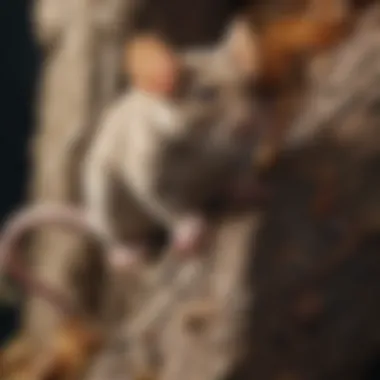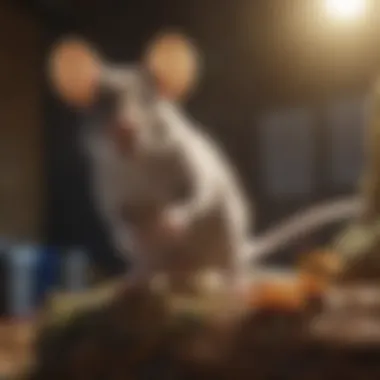Exploring Mice Climbing Skills and Pest Control Solutions


Intro
The climbing abilities of mice are not merely a curious topic; they hold significant implications for homeowners and pest management professionals alike. Understanding the anatomy and behavior of these small rodents is crucial for effective pest control strategies in urban environments.
Mice have adapted remarkably well to their surroundings. Their capacity to scale vertical surfaces and squeeze into tight spaces allows them to thrive in human habitats. This article will detail the various aspects of mice's climbing capabilities, from how they navigate their environment to the methods to prevent infestations in homes.
Pest Identification
Mice are more than just a nuisance in many households. Recognizing their presence early can ease the path toward proper control measures.
Common Household Pests
Mice, especially the house mouse (Mus musculus), are prevalent in urban settings. They often arrive unnoticed and can reproduce quickly. Their small size, averaging around 2.5 to 4 inches in length, makes them particularly adept at finding their way into homes. Some other common pests include:
- Rats: Larger than mice, they can also climb and adapt to urban life.
- Cockroaches: They can enter structures through various small openings.
- Termites: Although not climbers, their nests can pose serious property damage.
Signs of Infestation
Identifying the signs of a mouse infestation early is key. Common indicators include:
- Droppings: Mouse droppings resemble small black grains and are often found near food sources or nesting areas.
- Nibbled Food: Signs of gnawing indicate that mice are present.
- Noises: Scratching or scurrying sounds often heard at night can signal their presence.
"Early detection of mice can prevent serious infestations and mitigate extensive property damage."
Prevention Methods
Preventing mice from infiltrating a home requires a combination of environmental modifications and diligent maintenance.
Environmental Modifications
Modifying the environment around your home can significantly reduce the chances of a mouse invasion. Effective strategies include:
- Sealing Entry Points: Check for gaps in walls, floors, and around pipes. Use caulk or steel wool to seal these areas.
- Proper Waste Management: Secure garbage in rodent-proof containers and ensure waste doesn’t pile up.
- Landscaping Care: Trim back bushes or trees that provide easy access to your home’s foundation.
Home Maintenance Tips
Routine home maintenance can deter pests. Consider:
- Keeping food stored in airtight containers.
- Regularly cleaning areas like kitchens and basements to eliminate crumbs.
- Reducing clutter in storage areas and attics where mice may nest.
DIY Pest Control Solutions
In addition to professional services, various do-it-yourself options can be effective in controlling mouse populations.
Natural Remedies
Simple natural remedies may provide short-term relief. Some popular choices are:
- Peppermint Oil: The scent is said to repel mice. Place cotton balls soaked in peppermint oil near known entry points.
- Vinegar Traps: A mix of vinegar and water can attract mice and trap them effectively.
DIY Traps and Barriers
Creating traps can help manage populations. To craft a simple trap:
- Use a bucket filled with water and place a ramp leading to it. A weight or food bait on the edge can help lure the mice.
Foreword to Mice and Their Habitats
Understanding the causes and effects of mice in various habitats is crucial, not only for those studying animal behavior but also for homeowners dealing with infestations. Mice are versatile creatures that adapt effectively to both wilderness areas and urban environments. This adaptability makes them prevalent in many settings, impacting human dwelling spaces significantly. By examining their typical habitats and the species that thrive there, we can better address the challenges posed by these rodents.
Overview of Common Mouse Species


Mice comprise various species, each exhibiting unique behaviors and adaptations. The most recognized species include the house mouse, the deer mouse, and the field mouse. The house mouse is the most associated with domestic environments, thriving in homes and human structures. It is small, usually about 3 to 4 inches long, and is known for its adaptability to various living conditions.
The deer mouse, usually found in more rural or wooded regions, can travel over great distances. Its ability to climb and leap aids its survival in the wild, making it different from the more sociable house mouse. Lastly, the field mouse, residing primarily in grassy areas, showcases significant climbing abilities as it often needs to escape predators. Each species plays a role in the ecosystem, but they also present specific challenges when they enter human habitats.
Typical Habitats of Mice
Mice exhibit a range of habitats that reflect their adaptability. Common settings include urban areas, agricultural fields, and forests. In urban settings, mice can be found in basements, attics, and even inside walls. They seek warmth and food, which are often abundant in human homes.
On the other hand, rural habitats like fields provide natural shelter and food sources. Mice in these environments typically build nests in grass or undergrowth. The adaptability in their habitat choice enhances their survival, making it necessary for homeowners to understand these patterns to manage mouse populations effectively.
"Understanding the habitats of mice is key to prevention strategies. Identifying potential entry points in your home can assist in pest control efforts."
Anatomical Features Supporting Climbing
Understanding the anatomical features that enable mice to climb efficiently is crucial for both enthusiasts and homeowners. This knowledge serves not just to appreciate the biological design of these creatures, but also to inform pest control practices. By recognizing the specific adaptations that facilitate climbing, individuals can better prevent unwanted intrusions in their living spaces.
Physical Characteristics of Mice
Mice exhibit several physical attributes that contribute to their climbing abilities. Their small size, averaging around 6 to 10 inches in length excluding the tail, allows them to navigate tight spaces and climb with agility. The body mass is distributed in a manner that aids in maintaining balance while scaling vertical surfaces. Mouse fur also plays a role; while it provides insulation, it also offers slight friction against surfaces they climb.
Claw and Grip Adaptations
The claws of mice are specialized for climbing and gripping. Each toe is equipped with sharp, curved claws that enhance their grip on both rough and smooth surfaces. This claw structure allows mice to grasp onto tiny crevices, enabling them to ascend vertical walls or cling to trees. The toe pads contain small, flexible hairs that increase friction and provide more traction, essential when maneuvering in precarious positions.
Body Structure and Flexibility
Mice possess a highly flexible body structure. Their spines are made up of numerous vertebrae, allowing for a greater range of motion. This flexibility helps them twist and turn as they navigate various terrains. The combination of a long tail aids in balancing, acting as a counterweight during climbing. Mice can easily adjust their body angles, which facilitates effective movement across uneven surfaces. Their anatomical design showcases an evolutionary adaptation to climbing, making them proficient at vertical mobility.
In summary: The anatomical features of mice provide them with a competitive advantage in climbing. Understanding these features can help in developing effective management strategies for pest prevention.
Behavioral Aspects of Climbing
The climbing abilities of mice are not solely dependent on their physical anatomy; their behavior plays a significant role as well. Understanding the behavioral aspects of climbing can reveal the motivations that drive this activity, as well as the environmental factors that influence it. This knowledge is crucial for homeowners seeking to prevent infestations and maintain a healthy living space. Mice are inherently curious creatures, often driven to explore their surroundings. This exploration often leads them to climb, which aids their survival by allowing them to find food, evade predators, and seek out nesting spots.
Motivations for Climbing
Mice climb for several reasons. First, they tend to look for food sources. Their natural diets consist of seeds, fruits, and grains, which can often be found at higher levels. Additionally, climbing provides them with a strategic advantage against predators. The act of ascending allows mice to escape threats and find safer locations to navigate without being easily seen. Climbing behaviors are also influenced by social factors. For example, young mice learn climbing behaviors by observing their elders. This interaction fosters agility and adaptability within their communities. Understanding these motivations helps in implementing effective pest control strategies.
"Motivations like food seeking and safety define climbing behaviors in mice, highlighting the relevance of understanding these aspects in pest management."
Environmental Influences on Climbing Behavior
The environment greatly impacts mice climbing behavior. Various elements such as surface texture, availability of natural pathways, and human structures play a role in how mice interact with their surroundings. Surfaces made from materials like wood or rough-textured walls provide better grip for climbing compared to smooth surfaces.
Other environmental factors include the presence of potential threats and the availability of shelter. In urban areas, architectural features can either facilitate or hinder mice climbing. For example, overhanging roofs, vines, and nearby trees can serve as access points, allowing easy movement for mice from one point to another. Moreover, seasonal changes can affect climbing behavior. In colder months, mice may climb more frequently to find warmth or nests, while in better weather, they may explore openly across various surfaces. Homeowners should consider these environmental dynamics to prevent mouse entry and effectively reduce risks associated with infestations.
The Mechanics of Mouse Climbing
Mouse climbing abilities result from a combination of anatomical features and specific behaviors. This section focuses on the underlying mechanics that allow mice to effectively scale vertical surfaces. Understanding these mechanics is important for entomologists, homeowners, and pest control experts. It provides insight into how different structures influence mice's capabilities in various environments.
Weight Distribution and Balance
Mice exhibit a unique body structure that allows for efficient weight distribution. Their small size and relatively light bodies help them manage their weight while shifting their center of gravity during climbing. This balance is crucial when navigating narrow ledges or steep surfaces. Mice have a flexible spine that permits a range of motion, supporting their need to reposition quickly. When they climb, they often employ their tail for added stability. Their tail acts like a counterbalance, helping them maintain equilibrium as they traverse vertical surfaces.
- The rear legs are powerful and grip firmly, allowing for strong pushes upward.
- The forelimbs can reach up, grabbing surfaces securely as they ascend.
This coordinated effort between legs and the flexibility in their body ensure mice can climb effectively in a variety of settings.
Techniques for Vertical Mobility
Mice utilize specific techniques for climbing that take advantage of their physical attributes and the resources in their environments. Their climbing strategies can be categorized into several methods:
- Scrambling: Mice use their claws to dig into surfaces while using a combination of jumping and climbing. This is often seen on rough, textured materials.
- Creeping: On smoother surfaces, they adopt a more cautious approach, making careful movements to prevent slipping.
- Leaping: Mice can jump several inches vertically. This ability often helps them reach higher places quickly.
- Using the environment: Mice often navigate by using available structures such as pipes, walls, and gaps for support as they climb.


Each of these techniques showcases how mice adapt their climbing methods based on the materials around them. Understanding these mechanics provides critical knowledge for controlling pests effectively. By recognizing their capabilities, homeowners can identify vulnerabilities in their spaces and develop tailored strategies for prevention.
Factors Affecting Climbing Ability
Understanding the factors affecting climbing ability in mice is crucial for comprehending their behavior and adaptability. Mice are agile creatures, but various elements determine how effectively they can navigate diverse surfaces in their environments. By examining these factors, we gain insights that have implications not just for understanding mice but also for managing their presence in urban settings, where they can pose challenges as pests.
Surface Texture and Incline
The texture of a surface significantly impacts the climbing ability of mice. Mice rely on their claws and body structure to grip surfaces effectively. Rough textures provide better traction, enabling mice to ascend with greater ease. For instance, surfaces like concrete or tree bark offer ruggedness that enhances their grip. Conversely, smooth or slippery surfaces, such as polished metal or glass, present obstacles that restrict their climbing capabilities.
Incline also plays an essential role. Steeper gradients demand more energy and skill to navigate compared to gradual slopes. Mice have to adjust their approach based on the angle and stability of the surface, as these factors influence their weight distribution and balance. Therefore, when analyzing potential entry points in homes, consider both the texture and slope of nearby surfaces, as they dictate how easily mice can invade.
Age and Health of Mice
A mouse's age and overall health critically affect its climbing proficiency. Younger mice tend to display superior agility and energy, allowing them to climb more effortlessly compared to their older counterparts. With age, a mouse may experience a decline in muscle strength and coordination, which can impede its climbing ability. Additionally, health issues such as disease or injury can further restrict movement and climbing skills.
It is also important to note that environmental factors, such as availability of food or nesting sites, can influence the overall health of mice. A well-nourished mouse is likely to be more agile and better positioned to climb efficiently. In contrast, malnutrition can lead to weakness, significantly affecting a mouse's ability to navigate vertical surfaces.
"Understanding the varying impacts of surface texture, incline, age, and health on mice climbing abilities is essential for homeowners aiming to mitigate infestations."
These factors provide foundational knowledge that enables effective strategies in pest control. By recognizing how these elements interact, one can assess vulnerabilities in their living environment and develop more informed prevention measures.
Mice in Urban Settings
The presence of mice in urban environments presents unique challenges. In cities, these rodents often thrive, exploiting human-made structures for shelter and food. Understanding their habits and behaviors in such settings is crucial for effective pest control. The dynamics of urban architecture and daily human activities create specific opportunities for mice to invade homes and buildings.
Common Entry Points in Residences
Mice are highly adaptable creatures, and their climbing abilities enhance their potential entry points into urban residences.
Some common entry points include:
- Gaps and Cracks: Mice can squeeze through surprisingly small openings. Even gaps as tiny as a dime may serve as access points.
- Windows and Vents: Unscreened windows or poorly sealed vents allow mice to enter easily, especially if there are nearby structures to assist their climb.
- Pipes and Utility Lines: These often provide a conduit for mice to travel up walls and into living spaces without detection.
- Roof and Eaves: Climbing skills allow mice to reach roofs via tree branches or other nearby structures, accessing attics and upper floors.
Identifying these entry points is vital. Regular inspections and maintaining proper seals around potential openings can significantly reduce the likelihood of invasions.
Impact of Architecture on Climbing Dynamics
The architecture of urban environments can either facilitate or hinder the movement of mice. Features of buildings can create favorable scenarios for mice.
- Material Selection: Smooth surfaces can be challenging for mice, while roughened or textured materials give them more grip to navigate vertical spaces.
- Design/Layout: Buildings with multiple stories or balconies can become highways for mice. They can leap between ledges or climb exterior walls with greater ease.
- Design Flaws: Structural weaknesses, like misaligned windows or openings in walls, can serve as unintentional highways for climbing mice.
Understanding how urban architecture affects mice climbing dynamics enables homeowners and pest control professionals to develop targeted interventions. By addressing architectural vulnerabilities, they can mitigate the risks associated with rodent infestations, helping to safeguard living environments.
"An informed approach to understanding mice in urban settings is critical to effective pest management strategies."
Taking preventive measures and recognizing architectural features that promote mice mobility are essential steps in addressing potential infestations.
Implications for Pest Control Strategies
Effective pest control demands a clear understanding of mice's entry points and mobility. By prioritizing areas where these rodents are most likely to access, strategies can be tailored to prevent significant problems. For instance, identification of vulnerable areas can help in spotting potential entry points quickly.
Moreover, certain preventive measures are crucial for long-term protection. Homeowners can secure their properties by making adjustments based on the knowledge of mice behavior. This includes sealing gaps and holes that may serve as potential passages for mice.
Also, the use of deterrents and barriers can hinder mouse activity. Innovative solutions can add layers of security against infestations, interfering with their usual pathways and making access difficult. Combining these strategies can create a robust defense plan against mouse problems.
Identification of Vulnerable Areas
Identifying vulnerable areas is the first step in a successful pest control approach. Mice typically exploit structural weaknesses in buildings, such as gaps in walls, gaps around vents, and cracks in foundations. Additionally, areas where utility lines enter buildings are prime locations for entry.
A thorough inspection can reveal where these rodents might gain access. Commonly overlooked locations include:


- Basements: Often provide easy access due to multiple entry points.
- Attics: Can serve as nesting grounds if they enter undetected.
- Kitchen areas: Food sources attract mice, and small openings near appliances can be entryways.
Homeowners should be vigilant about these areas as mice can quickly reproduce. Regular maintenance of the home’s exterior can mitigate risks significantly.
Preventive Measures for Protection
Once vulnerable areas are identified, implementing preventive measures becomes essential. Sealing entry points can be done using materials like steel wool, caulk, or foam insulation. Doing this is crucial to limit the ability of mice to intrude into homes.
Additional preventive actions include:
- Ensuring food is stored in airtight containers to reduce attractants.
- Tidying up clutter in basements and garages to eliminate hiding places.
- Installing door sweeps on exterior doors to block entry.
Routine checks should emphasize these elements. Everything from doors to windows plays a role in maintaining a mouse-free environment.
Use of Deterrents and Barriers
A significant strategy in pest control involves the use of deterrents and barriers. Various products aim to create environments that are less inviting for mice. Many homeowners today are exploring both chemical and natural deterrents.
For instance, peppermint oil is often cited as a natural repellent. It can be applied around entry points to deter mice effectively. Similarly, ultrasonic repellents emit sounds that are unpleasant for mice but inaudible to humans.
Physical barriers also play a vital role. Metal mesh can be used to cover ventilation holes, while heavy-duty plastic can seal gaps under doors. Implementing combinations of these solutions enhances the defense against mice.
"Effective pest control goes beyond mere extermination; it requires understanding mouse behavior to establish long-lasting prevention strategies."
Sustainable Approaches to Mouse Management
Understanding sustainable approaches to mouse management is essential for both homeowners and pest control professionals. This section addresses the significance of eco-friendly methods to control mouse populations, which can lead to a healthier environment and more humane treatment of these creatures. Sustainable practices not only target immediate pest issues but also focus on long-term solutions that minimize harm to nature and improve the quality of life for residents.
Using sustainable methods reduces the reliance on harmful chemicals that can affect other wildlife and even household pets. Reducing chemical usage leads to less pollution in the environment, creating safer living conditions for everyone. By adopting these methods, households contribute to the broader goal of maintaining ecological balance.
Moreover, sustainable practices often result in cost savings over time. Initial investments in materials or systems might seem higher, but the longevity and effectiveness of these approaches can lead to reduced overall costs. Here are key benefits and considerations regarding sustainable mouse management:
- Reduced Environmental Impact: By using natural deterrents, we decrease the possibility of harming beneficial insects and local fauna.
- Healthier Indoor Environments: Less reliance on synthetic chemicals means better air quality inside homes.
- Improvements in Community Relations: Sustainable practices foster goodwill among neighbors, promoting cooperation in pest prevention strategies.
Implementing these methods requires thoughtful planning. Homeowners must assess their specific situations, including the extent of the mouse problem and the environment in which they live.
Eco-Friendly Pest Control Solutions
Eco-friendly pest control solutions are designed to address mouse infestations without causing damage to the surrounding ecosystem. These methods rely on natural compounds and ethical practices, making them suitable for families aiming to protect their living spaces while respecting wildlife.
Some effective eco-friendly solutions include:
- Essential Oils: Oils like peppermint and eucalyptus have strong scents that deter mice. Spraying diluted solutions in critical areas can be an effective barrier.
- Traps: Using humane traps allows for the capture and release of mice without causing harm. Proper placement near suspected entry points can increase efficacy.
- Natural Predators: Introducing natural predators, such as cats, can help to control mouse populations sustainably. This method should be considered carefully, as it involves balancing the local ecosystem.
- Food Source Elimination: Keeping kitchens clean and sealing food tight is crucial. Ensuring that no food sources are available will deter mice from settling in the first place.
"Adopting eco-friendly pest control methods not only helps eliminate mice but also protects the local habitat and improves the overall effectiveness of pest management efforts."
Community Efforts and Awareness Programs
Community efforts play a significant role in sustainable mouse management. Collaborative initiatives can amplify individual actions, leading to a more comprehensive approach against infestations. When neighborhoods work together, they can create shared strategies to prevent mouse problems.
Awareness programs are crucial in educating the public on effective pest control practices. These programs can include:
- Workshops: Hosting workshops that focus on sustainable practices encourages residents to learn and share effective strategies.
- Information Campaigns: Utilizing social media platforms, such as Facebook and Reddit, can help spread tips and methods efficiently. Educated community members become advocates for responsible pest management.
- Neighborhood Watch Programs: Forming groups focused on preventive measures can create a culture of vigilance, where residents actively monitor and report mouse activity.
Such community-driven approaches not only enhance awareness but also build more cohesive neighborhoods ready to tackle pest control in a responsible manner. The combination of individual and community actions can lead to a significant decrease in mouse populations, reinforcing the importance of sustainability.
The End
The climbing abilities of mice are multifaceted and more critical than often perceived. Recognizing their adaptations and behaviors is essential for understanding how they invade human spaces. This article has explored various aspects concerning these remarkable creatures, shedding light on their anatomy, mechanics, and the various influences on their climbing skills.
Summary of Key Points
- Adaptations: Mice possess anatomical features that significantly enhance their climbing abilities. The structure of their claws and their flexibility play a crucial role.
- Behavioral Insights: Their climbing often stem from instinctual behaviors—whether for foraging or escaping predators. Environmental factors also dictate their climbing behavior.
- Urban Dynamics: Understanding entry points and architectural designs helps in effectively managing mouse populations in urban areas.
- Pest Control Strategies: A knowledge of climbing abilities informs preventive measures, including barriers and deterrents.
- Sustainable Solutions: Eco-friendly approaches are fundamental in the long-term management of mouse populations while minimizing harm to the environment.
Future Research Directions
Future research could focus on several avenues:
- Climbing Technologies: Investigating how mice interact with different surface textures could lead to innovations in pest control methods.
- Behavioral Studies: A deeper analysis into how environmental changes affect climbing behavior may uncover new insights beneficial for pest management.
- Genetic Research: Exploring the genetic adaptations that support climbing ability might reveal fundamental biological principles.
- Urban Ecology: Examining the relationship between urban structures and mouse populations can refine strategies for their control in invasive settings.















